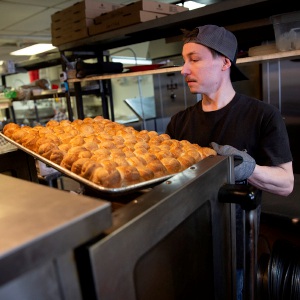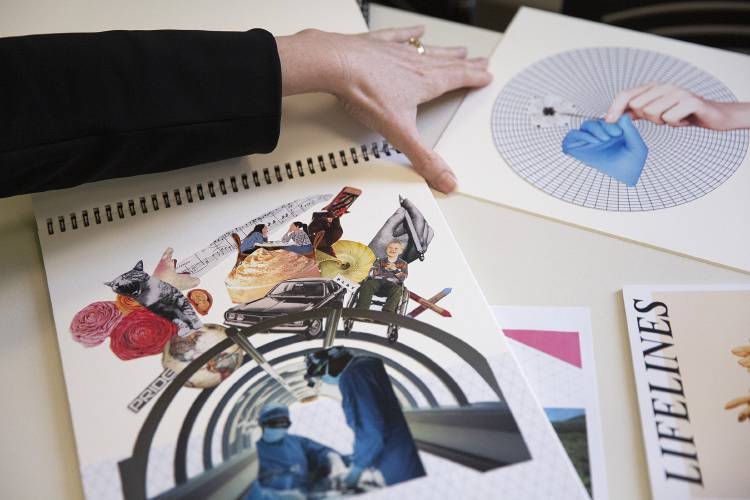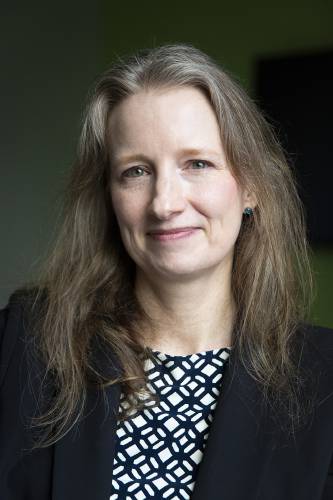Geisel professor seeks to humanize medicine through art
| Published: 03-21-2024 6:08 PM |
LEBANON — What if the American medical profession, known for its byzantine bureaucracy and grueling pace, had a mechanism to encourage empathy, listening and better communication?
It does, but it comes from an unexpected source — art.
Dr. Laura Tafe, an associate professor of pathology and laboratory medicine at the Geisel School of Medicine at Dartmouth College, is a molecular diagnostic and anatomic pathologist, diagnosing diseases by scrutinizing human tissue under a microscope.
She is also an artist who, in recent years, has focused on making collages in which she reimagines health care settings, turning them from bland monoliths into spaces where our basic humanity can thrive. Some of Tafe’s collages are included in the anthology “Artists Remaking Medicine” (Procedure Press), along with an essay that she has written.
Containing interviews, stories, images and essays by health care professionals, “Artists Remaking Medicine” examines the myriad ways the visual, musical and literary arts have the potential to alter a patient’s — and medical professional’s — experience within a health care system that can seem isolating and indifferent.
“There are so many stories of people wanting to be seen as the human that they are, both as a patient and as a health care worker. We need more of that human-centered care,” Tafe said in an interview at Dartmouth Hitchcock Medical Center in Lebanon, where she does her clinical work.
Three of Tafe’s collages are included in the anthology. In “Compassion,” one hand gives a flower to another hand wearing blue medical gloves. In “Personhood,” a team of surgeons open up a patient, whose inner life seems to float above the operating table as a series of images (a musical score, a globe, a cat, flowers). “Community” shows a hospital backdrop, with images of doctors in white coats, children and a burgeoning forest superimposed against an unremarkable edifice.
Tafe’s collages have also been included in group exhibitions at the AVA Gallery and Art Center in Lebanon.
Article continues after...
Yesterday's Most Read Articles
 Dartmouth administration faces fierce criticism over protest arrests
Dartmouth administration faces fierce criticism over protest arrests
 West Lebanon crash
West Lebanon crash
 Plan on track to ship Upper Valley mail to Connecticut for sorting
Plan on track to ship Upper Valley mail to Connecticut for sorting
 Lebanon’s Jewell back from auto accident, more aware of ‘drowsy driving’ dangers
Lebanon’s Jewell back from auto accident, more aware of ‘drowsy driving’ dangers
 Longtime employees buy West Lebanon pizzeria
Longtime employees buy West Lebanon pizzeria
After Tafe’s mother was killed in a car accident in 2014, Tafe, who lives in Lebanon, considered how to channel her grief and depression. She wrote voluminously to try to make sense of what had happened. “What do I want to have in my life? Art came up as something that’s always been important to me but which I haven’t put front and center.”
By 2019, she was making collages in earnest, usually at night, after work, when she was tired and more likely to free associate images and ideas. She works by hand, cutting out images from magazines (among other journals, she has a large collection of National Geographic), pasting them with glue onto paper “I really like the tactileness of it,” Tafe said.
The arc of a medical career is so all-consuming, from medical school to residency to practice, that it’s easy to forget, said Tafe, that “you have other elements of yourself that give you relief outside of your day-to-day life and job.”
The idea for “Artists Remaking Medicine” came out of Procedure Press publisher Emily Peters’ experiences as a patient, when she almost died in childbirth. As a writer, she told herself that she needed to take notes about what had happened to her and why.
“The issues are big and complex. There are dramatic and harmful levels of cost, disparities in care, racism and burnout,” Peters said in a phone interview. “What I found is that artists are really making a significant, measurable impact on these issues. They are helping to change the culture of medicine so that people feel they can make a difference.”
Peters pointed to a Japanese sound artist who, after a traumatic hospital stay when she was scared by the battery of beeps, bells and alarms coming from patient monitors, worked with German engineers to modulate the tones of monitors so they were less intrusive.
Hospitals, including DHMC, are incorporating the arts and humanities into their campuses and programming so that visitors, patients and staff are surrounded by a variety of visual and aural stimuli — not only a drab medical setting.
Using art, poetry and writing within the medical context are ways “to articulate feelings and connections and develop empathy. That can be utilized for anybody, really — for physicians, trainees and patients,” said Tafe.
Medicine should not be divorced from the so-called softer powers of empathy, attentive listening and skilled communication; and the arts are a way to inculcate and refine those skills in a health care setting, she added.
Indeed, the study of “narrative medicine,” which originated in 2000 in the Columbia University Department of Medical Humanities and Ethics and which features training in literary theory, philosophy, narrative ethics and the creative arts, “increases clinicians’ capacity to perceive the turmoil and suffering borne by patients and to help them to endure the chaos of illness,” according to the department website.
Peters said that publishing books such as “Artists Remaking Medicine” is a way to remain “optimistic and continue the work of improving the system.”
One of the key reasons Tafe is sharing her art with other medical professionals and students is that the arts and humanities were not part of her medical school experience. There were no mentors or role models who encouraged her to continue pursuing art and writing, in addition to her medical studies. Now, Tafe has been asked to become a faculty mentor for Lifelines, the annual literary and art magazine of the Geisel School of Medicine which celebrates its 10th anniversary this year.
Reading stories or personal reminiscences, or considering images that have some basis in medicine, “can be very humanizing and help us understand the impact our work will have on others,” said Lifelines Chief Editor Brendan Hines, a second year medical student at Geisel.
Tafe sees the aesthetic beauty in her work as a pathologist examining slides under a microscope.
“I love the details of the cells and the minutiae of all the mechanisms at play in the human body,” she said. “I’ve also always been attracted to the stars and astronomy: the ultimate hugeness to the ultimate tinyness. They seem connected to me.”
Nicola Smith can be reached at mail@nicolasmith.org.




